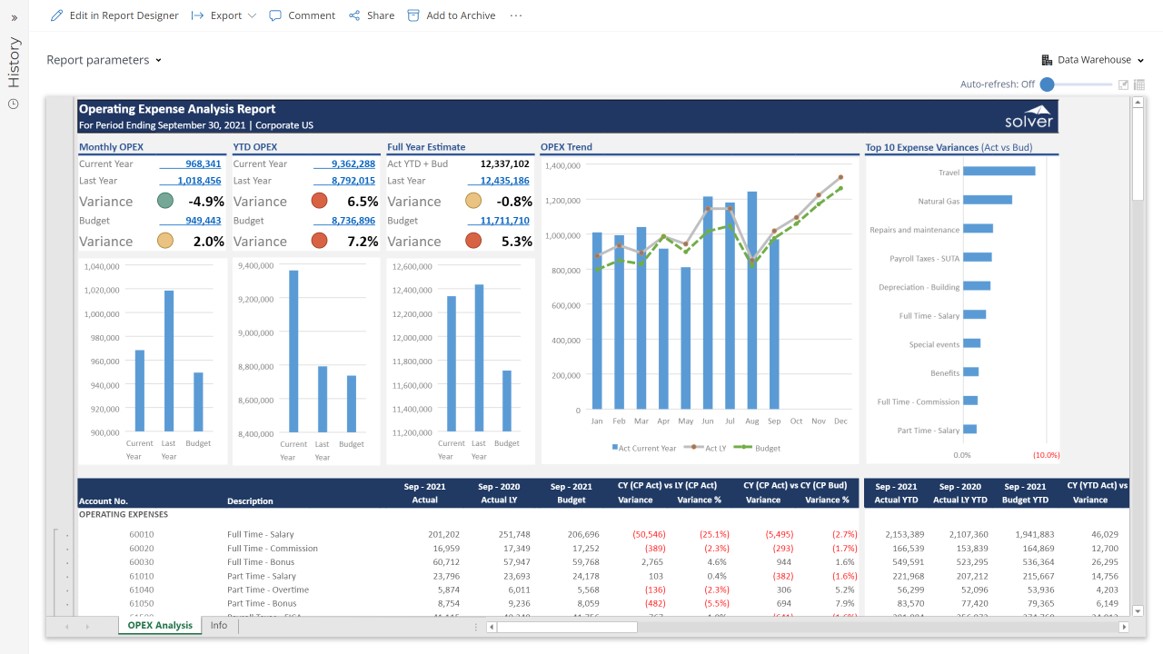Related Posts
- Subscription Billing Auto Forecast for SaaS Companies using Dynamics 365 Business Central
- Top 50 Opportunities Report for SaaS Companies using Dynamics 365 BC
- Subscription Sales by Contract Length Report for SaaS Companies using Dynamics 365 Business Central
- Multi-Year Profit & Loss Forecast Model for SaaS Companies using Dynamics 365 Business Central
- Lead Target Model for SaaS Companies using Dynamics 365 Business Central
Using Operating Expense Analysis to Streamline the Monthly Reporting and Analysis Process
- Monthly and YTD expense totals with variances to budget and last year actuals with drill-down to account level detail in report at the bottom
- Automatically calculated full year expense estimate as well as Top Ten Expense Variances
- Monthly trend chart comparing actual current year with budget and last year figures
 Example of an Operating Expense Analysis Report to Streamline the Monthly Reporting and Analysis Process[/caption] The Operating Expense Analysis is a ready-to-use Operating Expense Analysis Report from the
Solver Marketplace.
A Brief Description of the
Operating Expense Analysis
Template Operating Expense Analysis Reports like the one seen in the image above are interactive and parameter driven and typically contain sections with charts, expense summary and detail, and top variances. One of the important features that aid the user in the analysis process is the ability to view a powerful combination of summary metrics, traffic lights to highlight variances and charts to display trends. Operating Expense Analysis reports are often used in conjunction with revenue analysis reports, profit & loss reports, expense dashboards, and AP reports.
Data Integration to Transaction Systems Most organizations these days want automated and streamlined
planning,
reporting and
analysis. However, many of the benefits described earlier rely on best of breed Corporate Performance Management (CPM) tools and/or Business Intelligence (BI) capabilities as well as data marts or data warehouses that use pre-built integrations to the organization’s ERP system. Oftentimes, they also need integrations to other key data sources like CRM, subscription systems, payroll tools, etc. Modern, cloud-based ERPs like Microsoft Dynamics 365 Finance (D365 Finance), Microsoft Dynamics 365 Business Central (D365 BC), Sage Intacct, Acumatica, Netsuite and SAP have robust APIs which allow for dynamic integrations to CPM and BI tools that are fully automated and flexible to run on a schedule or on-demand.
Additional Resources to Aid with Research of Templates, CPM and BI Tools
Example of an Operating Expense Analysis Report to Streamline the Monthly Reporting and Analysis Process[/caption] The Operating Expense Analysis is a ready-to-use Operating Expense Analysis Report from the
Solver Marketplace.
A Brief Description of the
Operating Expense Analysis
Template Operating Expense Analysis Reports like the one seen in the image above are interactive and parameter driven and typically contain sections with charts, expense summary and detail, and top variances. One of the important features that aid the user in the analysis process is the ability to view a powerful combination of summary metrics, traffic lights to highlight variances and charts to display trends. Operating Expense Analysis reports are often used in conjunction with revenue analysis reports, profit & loss reports, expense dashboards, and AP reports.
Data Integration to Transaction Systems Most organizations these days want automated and streamlined
planning,
reporting and
analysis. However, many of the benefits described earlier rely on best of breed Corporate Performance Management (CPM) tools and/or Business Intelligence (BI) capabilities as well as data marts or data warehouses that use pre-built integrations to the organization’s ERP system. Oftentimes, they also need integrations to other key data sources like CRM, subscription systems, payroll tools, etc. Modern, cloud-based ERPs like Microsoft Dynamics 365 Finance (D365 Finance), Microsoft Dynamics 365 Business Central (D365 BC), Sage Intacct, Acumatica, Netsuite and SAP have robust APIs which allow for dynamic integrations to CPM and BI tools that are fully automated and flexible to run on a schedule or on-demand.
Additional Resources to Aid with Research of Templates, CPM and BI Tools
- Templates from Solver that are pre-built and that work out-of-the-box using the Solver CPM cloud. Click here.
- Template examples: You find more than 500 CPM and BI Template examples here.
- Interactive Dashboard examples: Try Power BI dashboard templates from Solver here.
- Software evaluation and selection:
- Vendor Comparison and ROI (free interactive tool)
- Evaluating planning, budgeting and forecasting functionality
- Evaluating Financial Reporting functionality
- Evaluating Dashboard functionality
- Evaluating Data Warehouse functionality to achieve “one version of the truth”
- Demonstrations and other specific assets: Solver Tour Central
- Using third party analysts and consultants to aid in vendor selection
- Creating efficient processes:
TAGS: Reporting, Forecasting, Analysis, Budgeting, CPM, KPIs, ERP, Dashboards, Financial Reporting, Compare CPM, Template Library
Global Headquarters
Solver, Inc.
Phone: +1 (310) 691-5300
